
Arrival of Hernan Cortes in Veracruz with blue eyes mestizo baby and syphilis sick Hernan Cortes, Diego Rivera mural, Presidential Palace, Mexico City/Legion-Media/Alamy
From the first outbreak of the disease in the late fifteenth century, it became common practice to blame someone else for the spread of syphilis. In the Ottoman Empire, syphilis was called ‘the Christian disease’, and in Asia it was thought to have a Dutch origin. In the end, the Europeans decided to blame the indigenous peoples of the New World, claiming that they were the source of the latest epidemic. So, where did the most infamous venereal disease first appear? How was it treated? And what did the classics of world literature write about syphilis? Medical historian Elena Berger explores all these questions and more.
A Gift from the New World?
In the early modern period, Europe saw a decline in the devastating infectious diseases that had plagued the continent during the Middle Ages. Leprosy had nearly disappeared: strict measures for isolating the sick had yielded the desired results. Outbreaks of the plague were more rare and considerably weaker. However, Europeans encountered a new disease at the beginning of the sixteenth century, which spread rapidly and covered vast territories. In terms of how it spread, it resembled the plague, although the symptoms were different. People afflicted by it had ulcers appearing all over their bodies, especially in the genital area. Fever and excruciating pains followed, sometimes driving them to contemplate suicide, and in the advanced stages, facial tissue was destroyed (the nose collapsed). The disease was easily transmitted and resisted medical intervention; even when it seemed that it was cured, a relapse could occur at any moment.
In 1495, at the onset of a major pan-European conflict, the multinational army of the French king Charles VIII occupied Naples. After capturing the city, the soldiers, mostly mercenaries, soon began to complain of fever and the appearance of extremely painful ulcers in the genital area. The illness spread rapidly, and after a while, Charles's troops were forced to leave Naples and then Italy altogether (though there were also military and political reasons for this decision).
According to some historians' estimates, the epidemic extended beyond Naples and affected one-twentieth of Europe's population within a few years. It spread to France, Italy, Germany, and Switzerland and soon reached Austria, Hungary, and Poland, resulting in the deaths of over 5 million people.

Albrecht Durer's Woodcut Of A Syphilitic Man Covered In Chancres. Note The Astrological Influence Suggested By The Zodiac Above Him/Leigion-Media/Alamy
The emergence of the new disease coincided with the era of the Great Geographic Discoveries, or the Age of Exploration, and so it was logical to assume that it was brought to Europe from the New World. Additionally, some former Spanish sailors in Charles's army had participated in Christopher Columbus's expedition and had been to the island of Haiti, where they encountered the local natives and likely contracted the disease. Active international contacts enabled local diseases to spread much faster, and the epidemic then spread across Eurasia, from west to east, and reached India through trade routes. Initially, researchers believed that Vasco da Gama's expedition brought syphilis to Asia, but recent data demonstrates that syphilis was present in China between 656 and 1147 CE. Traces of syphilis have also been found in the skeletons of English monks from the fourteenth century, who obviously violated their vow of celibacy. So, Europeans hardly had any justification to blame America, and the New World, for everything.
Why Was It Called Syphilis?
For a long time, the new disease did not have a fixed name. Residents of different regions blamed strangers from nearby and distant countries. Since it was first recorded in Naples and quickly spread northward as the army advanced, the first commonly accepted name became ‘Neapolitan disease’. However, the Neapolitans preferred to call it the Gaulish or French disease, and as it spread through Europe, various names emerged. In Poland, it was called the German disease; in Russia, it was the Polish illness; in Eastern Asian countries, it was the Dutch or Portuguese disease; and in Turkey, it was the Christian disease, as it was believed to have spread to the Ottoman Empire from neighboring Christian countries. Later, it was called the Chinese disease or Chinese ulcer in Mongolia because the ailment was primarily transmitted through Chinese soldiers and merchants.
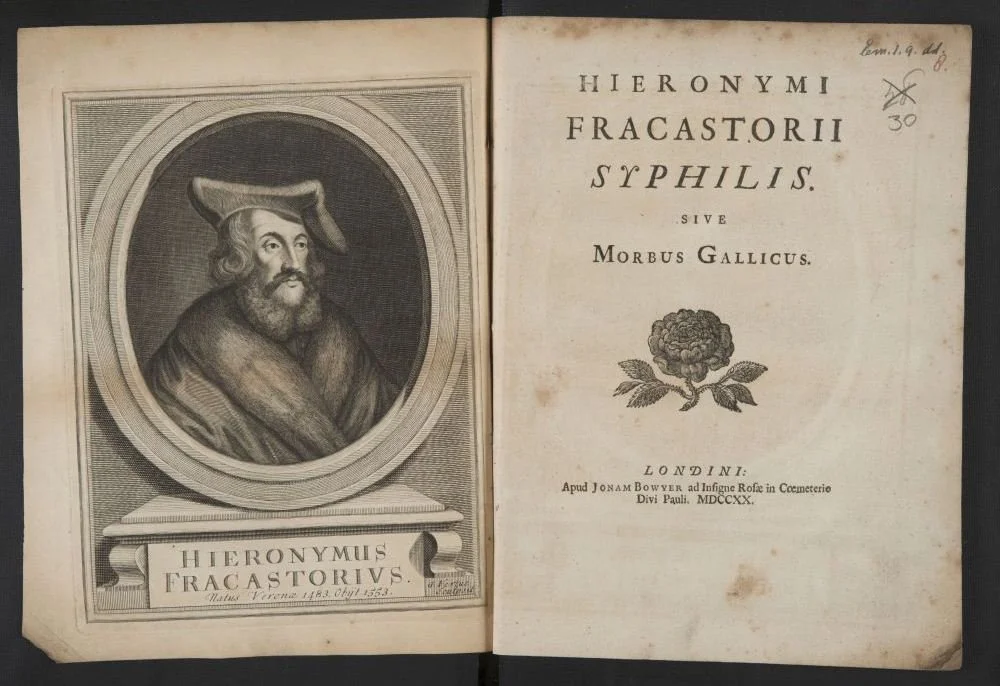
The poem by J.Fracastoro «Syphilis, or the Gallic disease». London edition/Wikimedia commons
However, its most widely accepted name, and what it is still known as, came from an unexpected source. In 1530, a poem by the Veronese physician and astrologer Girolamo Fracastoro (1478–1553) was published under the title ‘Syphilis sive Morbus Gallicus’ (‘Syphilis, or the French Disease’). It tells the story of a shepherd named Syphilus, who lived on the recently discovered island of Hispaniola (Haiti). He had angered the gods and was punished by being given a terrible disease. But when Syphilus repented his transgressions, the goddess Juno sent the seeds of a tree from heaven that would put an end to his suffering.
Thus, the author of the poem believed that the new disease, as well as its remedy, originated in the lands of the New World. The illness was believed to be a punishment from the gods for inappropriate behavior. Finally, the natives treated it with a decoction of the bark of the guaiacum tree. Thus, these three conclusions formed the basis of the initial understanding of the new disease.
Who Is to Blame and What Is to Be Done?
Physicians, priests, rulers, and philosophers pondered the causes of syphilis. A crucial question was whether it was an entirely new disease or something that was already known. From the outset, preachers proclaimed it as a disease sent by the Almighty for sins, as stated in the story of Job in the Old Testament: ‘My bones stick to my skin and my flesh, and I have escaped death by the skin of my teeth’ (Job 19:20). The Church claimed that prayer and universal repentance were the main remedies for syphilis.
Physicians, on the other hand, encountered a dilemma. If the disease was documented in ancient medical texts, they could draw upon their experience to devise effective treatment. However, if syphilis was previously unknown, they would, in all likelihood, need to base their approach on historical precedents and what ancient tradition recommended for handling similar cases.
So which of the ancient skin diseases did this new disease most resemble? It seemed the most like leprosy, but the doctors were confident that it was not. Leprosy spread slowly and was far less contagious than this new, unknown disease. Perhaps it was a form of the skin disease described by Galen as ‘elephantiasis’.
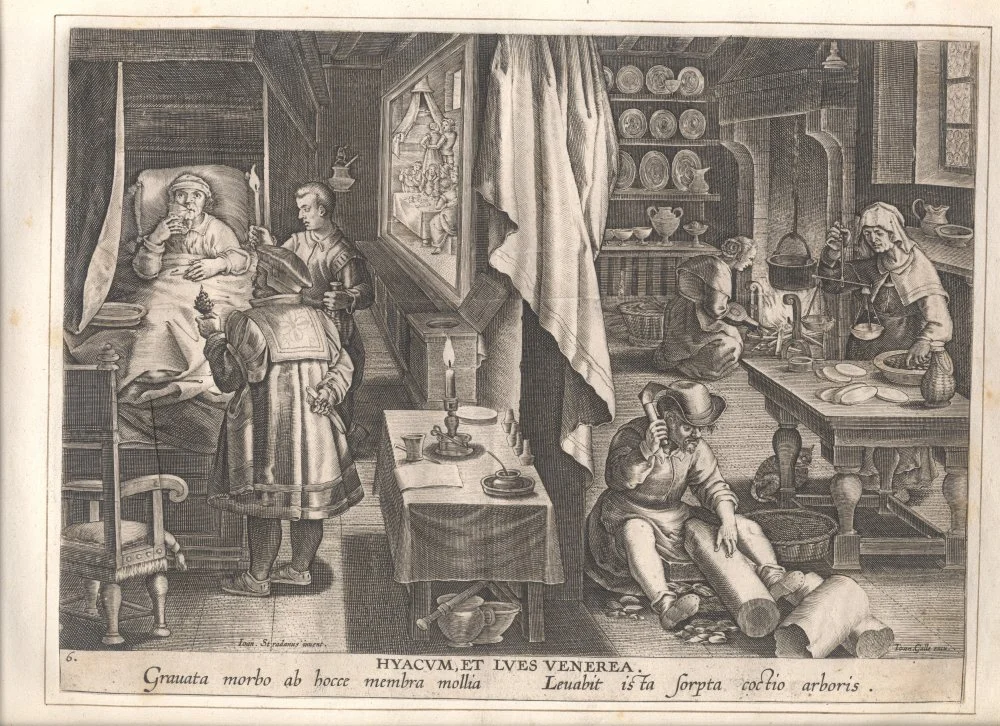
The discovery of guaiacum as cure for syphilis, 1590/Plantin–Moretus Museum/Antwerp,Belgium/Wikimedia Commons
In the case of the new illness, it could spread through the air, sexual intercourse, or close contact with an infected person, or be transmitted to a child through breast milk. Perhaps it was the same disease that the ancient Roman encyclopedist Celsus and the Arab physician Avicenna called ignis sacer (holy fire) and explained as an excess of black bile.
Over the years, the discussion continued, with new theories emerging all the time. Perhaps the Gaulish disease was the result of unpredictable climatic changes. The warm and humid climate that persisted in 1455–56 created the perfect conditions for genital ulcers to fester. Astrologers believed the epidemic was the result of planetary constellations and claimed it could have been predicted and even prevented.
But, of course, the main question remained: could this disease be cured? Physicians had different experiences, partly because the disease had periods of improvement and remission. Despite this, Italian hospitals for syphilitics were commonly labeled as ‘for the incurable’. Often, those afflicted with the Gaulish disease were housed in abandoned leprosariums, or shelters for lepers. However, creating strict isolation conditions for these patients in Europe was challenging.

Portrait of Gerard de Lairesse by Rembrandt van Rijn, ca. 1665–67 De Lairesse, himself a painter and art theorist, suffered from congenital syphilis that severely deformed his face and eventually blinded him/Metropolitan Museum of Art, New York/Legion-Media
It became evident rather soon that syphilis was primarily transmitted through sexual intercourse. Therefore, prostitutes and other marginalized individuals were primarily at risk. Unsurprisingly, myths quickly arose around the new disease. It was said that one could contract it through shared utensils, clothing, or even through the air. Europeans began to regard water as a potential source of different diseases, including venereal ones. Bathing was condemned as immoral since it involved being alone with one's own body, potentially leading to impure thoughts.
In France, a pamphlet titled ‘Christian Instruction on the Harm of Joint Bathing’ was highly popular. Some doctors considered bathing not only sinful but also simply dangerous: warm water opens the pores on the skin, providing the opportunity for any disease, especially syphilis, to penetrate through. Public baths in cities became increasingly scarce, and subsequently, rubbing the body with spirits or toilet water was considered safer. Although experience showed that the ‘household’ transmission of the disease was unlikely, the fears persisted as the following extract from Girolamo Fracastoro's ‘Syphilis sive Morbus Gallicus’:
‘There is no doubt for anyone that the disease is transmitted from one person to another through contagion.1
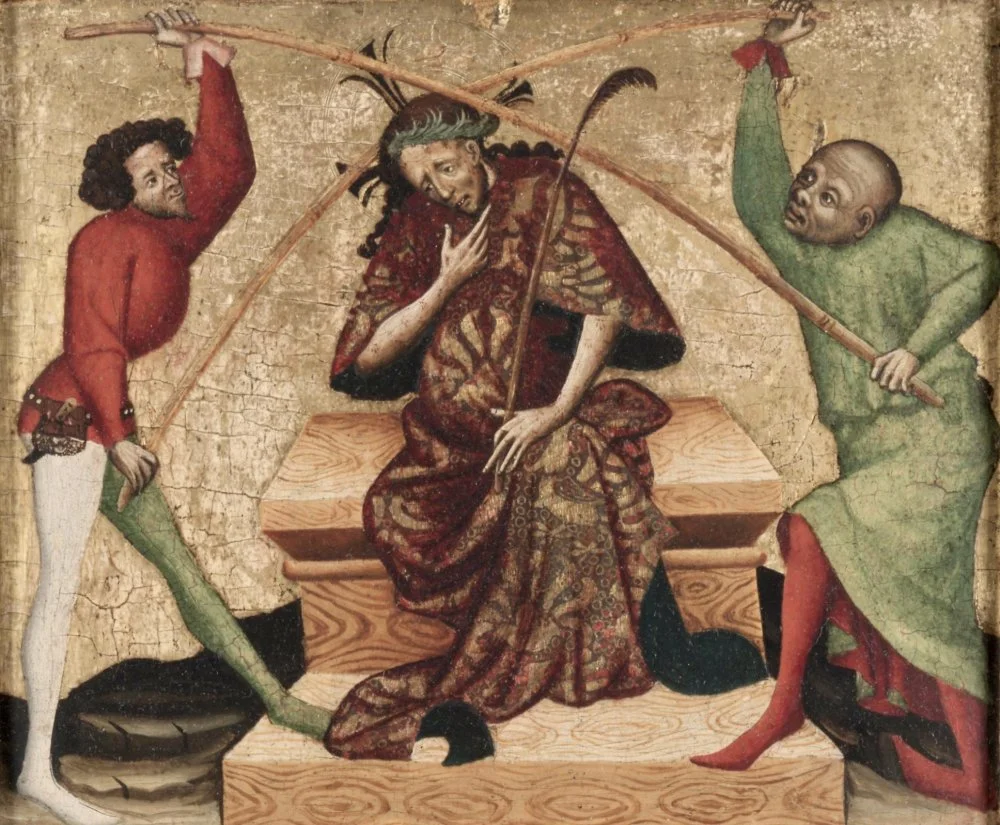
A healthy man and a diseased man torture Christ before his crucifixion. Books of Hours, c. 1375-1435 (detail). France. (Getty Museum Open Content Program)/Wikimedia commons
And What of Asia?
Various regions in Asia suffered greatly from syphilis as well. Even in the early twentieth century, in Kazakhstan and Mongolia for example, the incidence of venereal diseases was very high, leading to low birth rates and high infant mortality. Despite this, Mongolians regarded venereal diseases ‘extremely calmly, considering them quite natural for humans’. Moreover, among Mongolian peoples, syphilis was not considered a contagious disease, and infected individuals were not isolated. Mongolian peoples believed that venereal diseases were a punishment inflicted by evil spirits and deities, and so they were treated with rituals and sacrifices.
As Buddhism spread across Mongolia, Tibetan medicine began to be used there. According to Tibetan beliefs, syphilis is linked to the ‘sae’ tree, whose sap is said to poison the blood and lead to ulcers. The Tibetan name for syphilis is sae-duk, meaning ‘poisoning by the sap of the sae tree’.
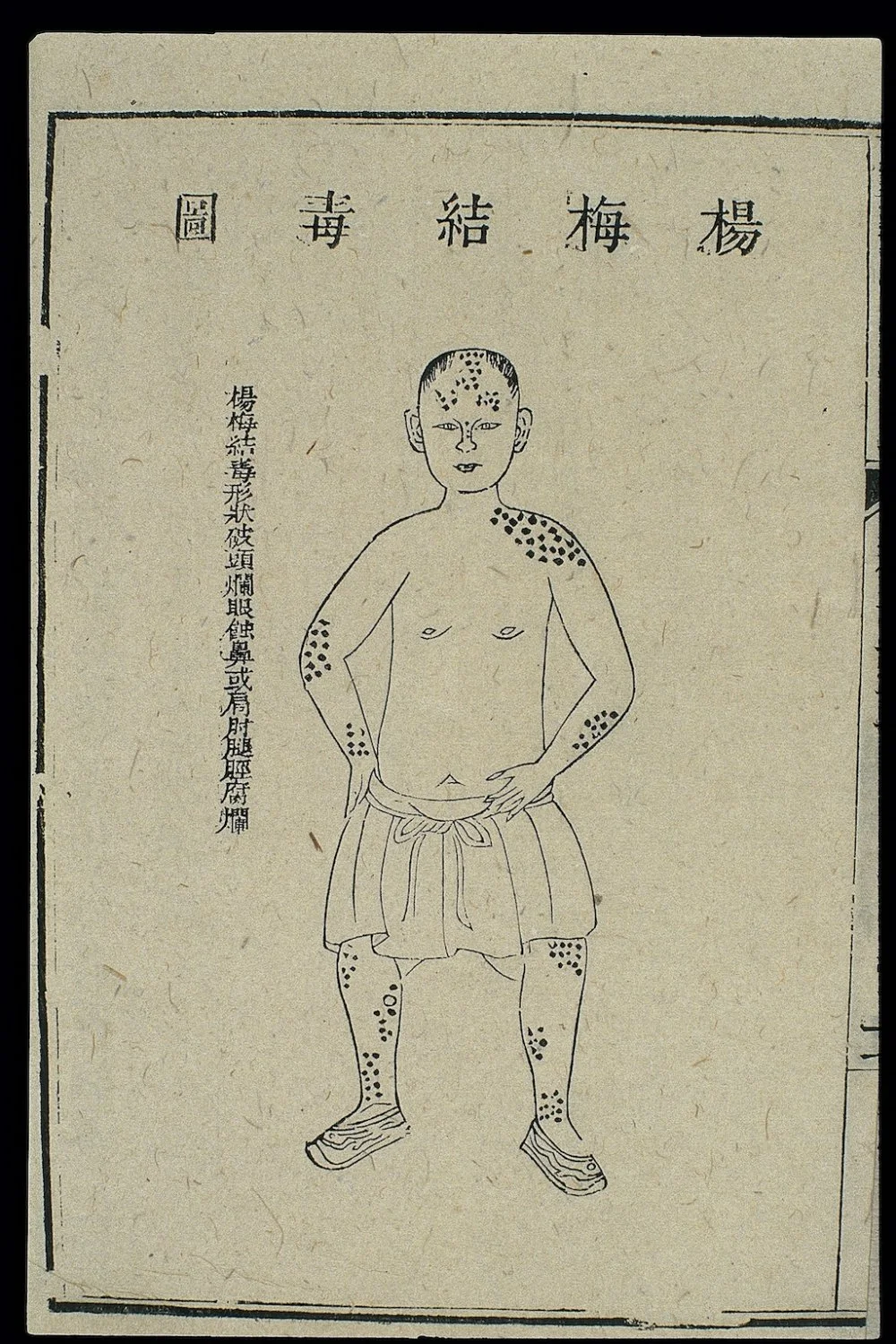
Syphilitic sores depicted in Yuzuan yizong jinjian (China, 1742)/Wikimedia commons
Tibetan emchi lamas (healers), like European doctors, used mercury compounds, predominantly cinnabar, to treat syphilis. In addition to internal use, fumigation was also used. Healing plants and animal-derived remedies, such as animal blood, bear bile, and musk, were used to alleviate the symptoms of the disease. It was believed these remedies helped with diseases caused by poisons, worms, and demons.
Mineral and medicinal baths were also often prescribed to treat syphilis. Mongolian people believed that taking medicinal and mineral baths could heal them in a miraculous way because the source was endowed with its own guardian spirit. Mongolians endowed mineral waters with sacred properties, and as researchers have noted, ‘all the inner walls of water structures are covered with prayers—the sick descend into the bath and, sitting in it, constantly recite rosaries and whisper prayers’. However, such procedures did not yield the desired results and often contributed to infection as sick and healthy people could come into close contact with each other during these baths.
Not a Disgrace, but a Misfortune
Strangely enough, syphilis quickly ceased to evoke horror and became something mundane. It proved to be less terrifying than leprosy or the plague. People did not flee in panic from it, and those afflicted with syphilis were not subjected to the harsh segregation endured by lepers two centuries earlier. Perhaps this was because the disease underwent a relatively rapid transformation. Now, it exhibited more diverse symptoms, including baldness, tooth loss, and blindness. In its most severe and almost incurable forms, syphilis became predominantly a disease of the poor as they could not access serious treatment, which was expensive. But overall, the course of the disease became milder, and syphilis became a subject of mockery. It was now considered acceptable to ridicule the disease and sometimes even to boast of having it. After all, it meant you were successful with the opposite sex. A nobleman was now considered worthless if he did not contract the disease and did not defy fate, mocking the punishment inflicted on him by the Almighty. This attitude was evident in the way characters appeared in works like Shakespeare's comedy Measure for Measure. In another instance, in one French city, the leader of the local youth, upon election, was granted the title Grand Patriarch of Syphilitics.
First Gentleman:
They drained all my money and left me with nothing but a nose.
Lucio:
It's good that you have a nose; what if you didn't?
First Gentleman:
You're insinuating some illness I have, but that's a misconception—I'm healthy and strong.
Lucio:
Not exactly healthy, but strong, like hollow things inside: your bones are hollow, your debauchery has consumed you!i
Measure for Measure, Act 1, Scene 2.
Nevertheless, the predominant feeling towards venereal diseases in Europe was not fear but shame. Syphilis was considered a disgraceful illness, with blame often placed on those who had it. Gossip didn't even spare those who contracted it through violence or misfortune.
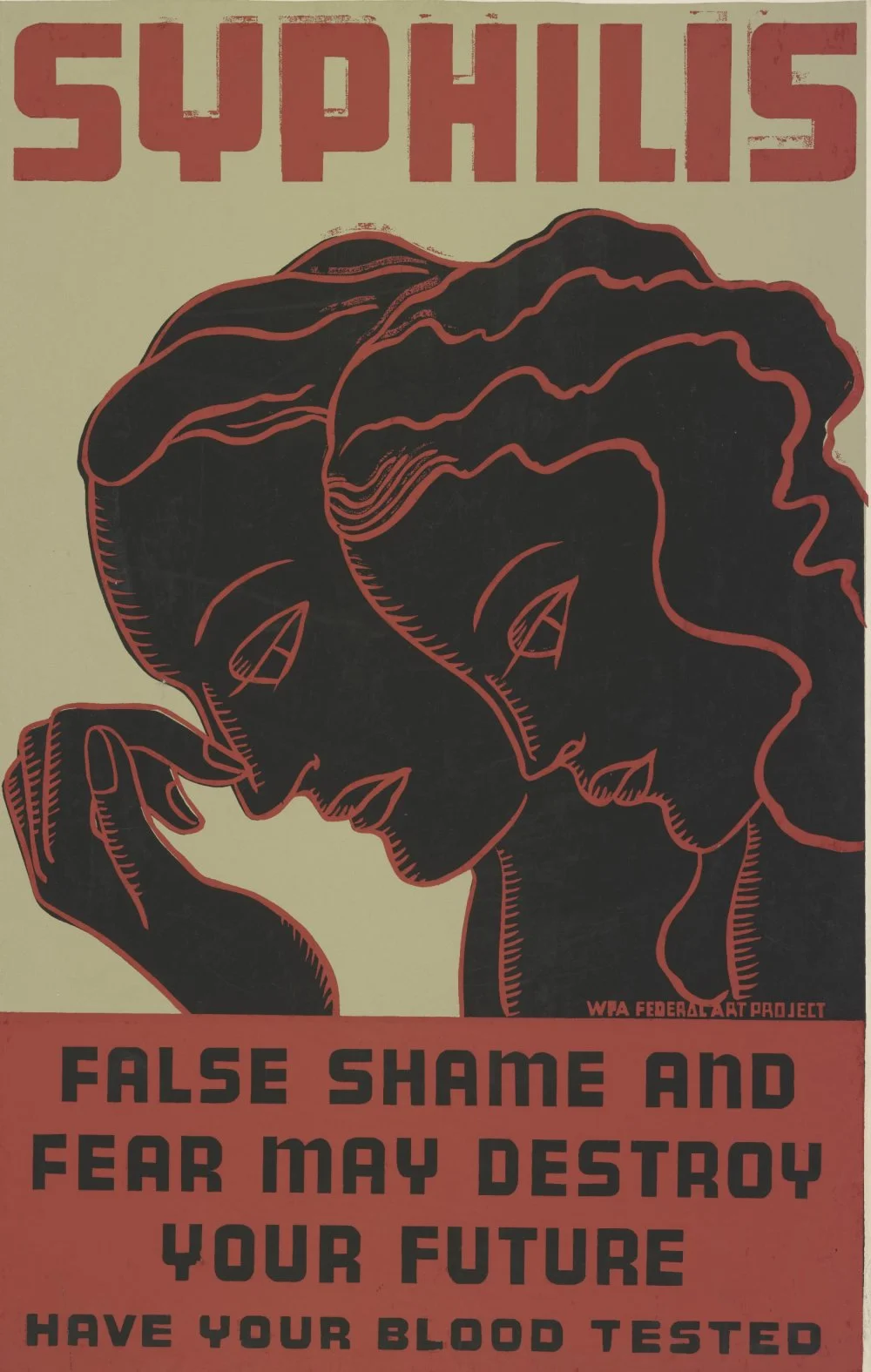
Syphilis false shame and fear may destroy your future/Wikimedia commons
In the eighteenth and nineteenth centuries, governments began to take centralized action to combat the spread of syphilis. For instance, there were numerous attempts to regulate prostitution as it was the main way in which syphilis was spreading. However, completely closing or banning all brothels was never a successful endeavor as they continued to operate clandestinely. Therefore, in countries like Germany and France, prostitutes were required to undergo regular medical examinations and, if necessary, receive treatment in hospitals for venereal diseases. These measures proved ineffective partly because doctors only examined prostitutes, neglecting their clients. Additionally, women made efforts to avoid being seen by doctors and concealed signs of the disease.
Syphilis and Women's Rights
In the second half of the nineteenth century, the term ‘social diseases’ began to gain traction in the medical community. This concept referred to diseases whose emergence and spread largely depended on unfavorable social conditions. These illnesses primarily included alcoholism and venereal diseases. Doctors and social activists argued that prostitution, in the vast majority of cases, women turned to prostitution due to desperate circumstances and their inability to make a living through lawful means. They hoped that changes in the state's social policies and the development of the women’s labor market would lead to the disappearance of prostitution along with venereal diseases.

Soviet poster against syphilis/from open access
Similar fates of women are depicted in classical novels from different parts of Europe, such as in this scene in Victor Hugo’s Les Miserables:
‘What is Fantine's story? It is the story of society buying a slave.
From whom? From poverty.
From hunger, from cold, from loneliness, from deprivation. A sorrowful transaction. Selling one's soul for a piece of bread. Poverty offers, and society accepts the offer.
... It is said that European civilization has abolished slavery. This is a misconception. It still exists, but now its burden falls solely on women, and its name is prostitution.’
Similarly, a scene in Fyodor Dostoevsky’s Crime and Punishment describes the lot of women who have no choice but to turn to prostitution:
‘Now, my gracious lord, I address you with a personal inquiry: How much do you believe a poor but honest girl can earn through honest work? Fifteen kopecks a day, sir, she won't earn, even if she's honest and lacks special talents, and works tirelessly! ... And there are hungry children ...
Around six o'clock, I observed Sonya getting up, donning her kerchief and cloak, and leaving the apartment; then, around nine o'clock, she returned. Upon her return, she went directly to Katerina Ivanovna and silently placed thirty kopecks on the table.’

R.Casas. Syphilis. An advertising poster of the sanatorium. 1900. The National Museum of Art of Catalonia. Barcelona/Wikimedia Commons
The notion of altering the social structure as a crucial element in combating diseases gained traction and was developed further in Soviet Russia. Gender equality was proclaimed, with alcoholism and prostitution being deemed legacies of the tsarist regime. It was believed that the social rehabilitation of women and their equal participation in constructive work alongside men would lead to the development of the nation and a sharp reduction in venereal diseases. N.A. Semashko, the first People's Commissar of Health, championed the slogan: ‘Illness is not a disgrace, but a misfortune.’ Sanitary and health propaganda stressed the importance of individuals infected with syphilis promptly disclosing their condition and initiating treatment right away to prevent endangering others. Doctors, however, noted a significant challenge: rural residents often treated syphilis infections with indifference, failing to recognize the danger to themselves and their families. This was highlighted by M.A. Bulgakov, who served as a rural doctor in the post-revolutionary era: ‘I came to realize that syphilis was terrifying here precisely because it wasn't feared.’
Various methods were employed for public health education. Many writers, poets, and artists considered participating in sanitary propaganda a matter of honor and a duty. Various artistic forms—posters, brochures, lectures, plays, and dramatizations—contributed to the fight against venereal diseases.
‘At times, enlightenment led to paranoia. In January 1932, the newspaper Izvestia wrote: “Persistent rumors are spreading in Moscow that Dukat cigarettes are contaminated with syphilis and sap. The rumors have become so widespread that Izvestia itself thought it necessary to intervene. The organ of the Central Executive Committee reassures the population, calling the rumors false and assuring that cigarette production takes place in hygienic conditions.’i

F.I. Rossinsky. Conversations about women's diseases. 1924/from open access
The Magic Bullet, or Preparation 606
In the sixteenth century, mercury was the most common treatment for syphilis. At the time, treatment involved fumigating patients with mercury vapors and rubbing preparations made with mercury into their skin. It was a long and agonizing process, and even with a favorable outcome, it resulted in mercury poisoning, including for the physicians conducting these procedures. A bitter joke gained popularity: ‘One day with Venus, a life with Mercury.’
Another remedy for syphilis was the bark of the guaiacum tree, imported to Europe from the New World. Indeed, guaiacum bark has anti-inflammatory effects (it was also used to treat rheumatism and gout). But the drawbacks of such a treatment are obvious—the medicine was scarce and, consequently, costly. Paracelsus, one of the most famous physicians of the sixteenth century, considered such treatment fraudulent. He claimed that the popularity of guaiacum as a treatment was fabricated by the Fugger bankers of Augsburg. They were, after all, the leading importers of American wood to Europe and made giant profits from selling the ‘miraculous remedy’.

Administration of the drug "606" to an infant suffering from congenital syphilis. Date of shooting: 1910/Wikimedia Commons
For a long time, mercury and guaiac remained practically the only means of treating syphilis, but a huge breakthrough occurred in the early twentieth century. In 1907, the German scientist Paul Ehrlich synthesized a drug based on arsenic intended for the treatment of syphilis. The new medicine was named salvarsan, from the Latin words salvum (meaning safe) and arsenicum (meaning arsenic). Another name for salvarsan was Preparation 606, indicating that the creation of the drug had been preceded by 605 unsuccessful experiments.
The advent of salvarsan marked the birth of chemotherapy, or treatment with chemical substances. It was a new-generation drug, and P. Ehrlich called it a magic bullet. Salvarsan became a drug with targeted action—it was supposed to selectively destroy the causative agents of the disease while remaining safe for the organism as a whole. Of course, his dream was not fully realized. Although salvarsan cured even advanced stages of syphilis, it was not entirely safe. After some time, Drug 914, which was named neosalvarsan, was synthesized. It was safer and had fewer side effects. The drug was used for several decades until it was discovered in the 1940s that syphilis responded well to treatment with penicillin.
What to read
Булгаков М.А. Звездная сыпь. — Спб., 1993.
Bashkuyev, V.Y. Russian Medicine and the Mongolian World. Irkutsk, 2016.
Mayakovsky, V.V. Syphilis.
Fracastoro, G. On Syphilis. Moscow: Medgiz, 1956.
McNeil, W. 2021. Epidemics and Peoples. Moscow: Dmitry Pozharsky University Press.
Nutton, V. 2022. Renaissance Medicine: A Short History of European Medicine in the Sixteenth Century. London; New York: Routledge.